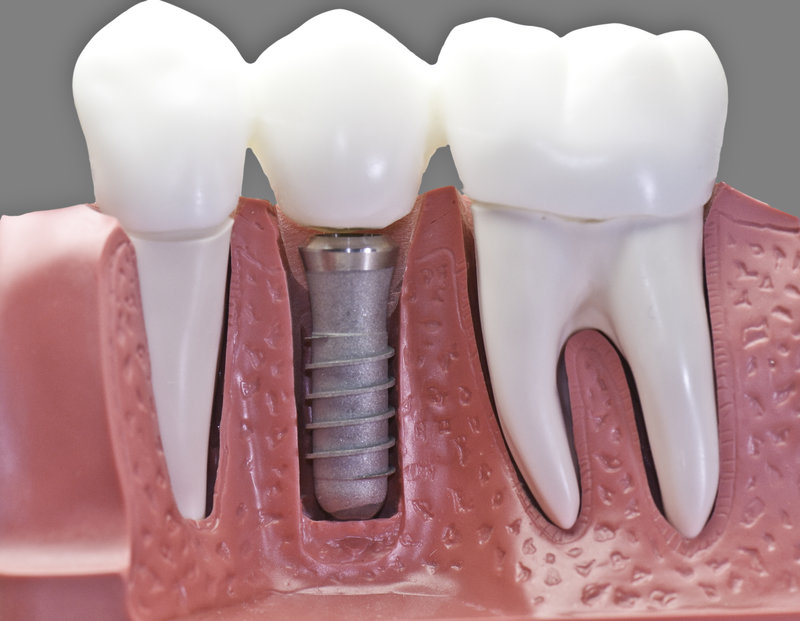Are Dental Implants Permanent?

Dental implants are designed to be permanent and rarely have long-term complications. For patients who suffer from severe tooth decay, infection, periodontal disease, have lost a tooth or teeth in an accident, or who are tired of the pain, irritation and discomfort associated with dentures, dental implants are a wonderful option.
When compared with dentures or partial dentures, which must be maintained with relines or replacement every few years, dental implants are a much healthier and long-term solution to tooth loss. They are stronger, do not shift or move in the mouth, and dental implants also allow you to speak, eat and smile naturally.
Dental Implants Mimic Your Natural Teeth
Dentures or partial dentures that sit on top of your gums or dental bridges and require cutting down adjacent teeth are merely tooth substitutions. However, dental implants are true tooth replacements. They are inserted into your jawbone where they become integrated with the bone itself and stimulate the bone like tooth roots to prevent the jawbone from dissolving away. When this “osseiointegration” is complete, the bone and titanium implant post are fused together and act very much like natural teeth.
This is what makes dental implants so much better than dentures. The integration of the implant’s post into jawbone helps support the bone and gum tissue structures so they are stronger and keep their original anatomical shape.
Tooth loss causes the jawbone to deteriorate over time. This has a dramatic effect on the shape of your face as you age, as well as your ability to speak and eat. Dentures, which sit on top of the gums, apply pressure that accelerates bone loss in the jaws! The jawbone changes shape, which means more routine visits to the dentist in order to have denture refitted and reshaped.
Many people find that replacing their dentures with dental implants transforms the way they feel and smile, restoring a confidence they haven’t felt in years. Do keep in mind that dental implants are best when fixed into the jaw sooner – rather than later – after a tooth is removed in order to give the implant’s post the strongest bone foundation possible. Bone grafting is also an option if bone deterioration has already begun and can often be completed at the same time as a tooth extraction and dental implant placement.
How Are Dental Implants Placed?
Dental implants are placed by a gentle surgical procedure which is done by an oral surgeon. Patients have a full consultation and examination by the oral surgeon who will help to complete the treatment plan. Most patients are candidates for implant treatment. Your surgeon will evaluate your oral condition and general health when advising your care. Age is not a factor! Our surgeons have placed implants for patients well into their 90s! Most times your tooth can be removed and a dental implant can be placed in one step. It’s very uncommon to need multiple steps unless you have been missing teeth for a long time.
There are several different options when it comes to dental implants:
- Single tooth implants, where each tooth is replaced by a single implant with it’s own abutment and crown.
- A fixed complete denture implant or a dental implant bridge where posts are fixed at certain locations along the jaw and then a bridge of prosthetics is attached to the posts.
- Removable denture with implant retention, where the implants are placed but the denture is designed to snap on and off of the implants.
Your dentist and oral surgeon team will be able to discuss which of these options makes the most sense for you based on the number of teeth that need to be replaced, the location of the replacements, and your health.
After implant placement, you’ll need to take some simple, easy steps to care for your healing implants. Over the healing period, you’ll take care not to bite down on foods with your implant and gently clean them. There is typically very little soreness and most people are able to go back to work within one to two days of the implant placement. In fact, there’s usually less soreness with a dental implant in the socket than if the tooth was extracted with no implant!
After the healing process, we’ll use an innovative, digital white light camera to create a digital model of your mouth in order to create permanent implant crowns that are artistically designed, shaped and colored to match your existing teeth. There’s usually no need to have a sticky traditional impression! If you’re replacing all your teeth, we’ll design teeth that look attractive and are proportioned to your mouth, jaw, and face shape, so your smile is both natural and radiant.
Once the “new teeth” are cemented or snapped in place, your diligent care of the teeth, oral hygiene habits, and regularly scheduled dental visits will help your dental implants last for many years.
Are You Interested in Getting Dental Implants?
Why deal with the discomforts and hassles of dentures when you don’t have to? Lucky for you, you’re already with the right dentist. As an ASIRD member, your dentist has been identified as an expert in the field of dental implants. Schedule a consultation to discuss whether you’re a good candidate for dental implants. Your dentist and surgeon team are ready to get you smiling again!